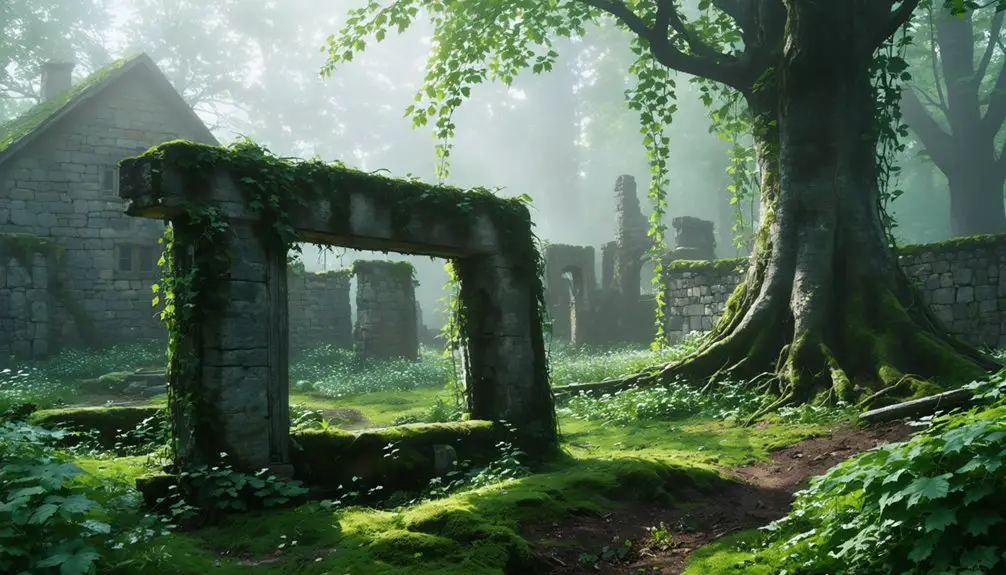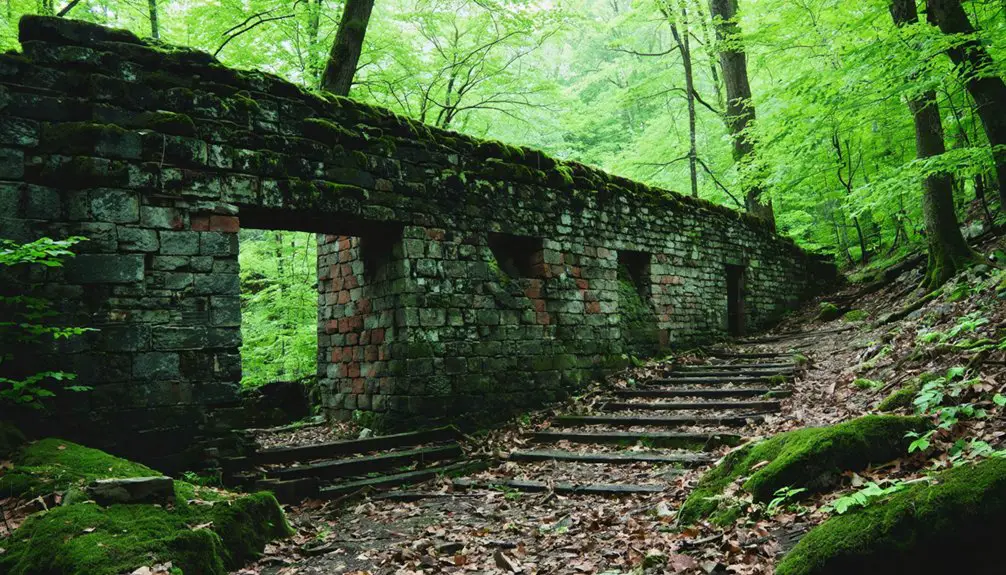You’ll discover Celestia, an 1850s ghost town founded by Peter E. Armstrong in Pennsylvania’s Endless Mountains, where he deeded 181 acres to God for His prophesied return. The millennialist community thrived with over 300 lots sold to followers who shared farming duties and wool production. Today, you can explore the scattered ruins, including foundation stones and the Stone Church – the last standing structure. The site’s untold stories wait beneath the wilderness.
Key Takeaways
- Celestia was a religious commune established in 1850 by Peter E. Armstrong, who purchased 181 acres in Pennsylvania’s Endless Mountains.
- The town was deeded to God and organized into squares with over 300 lots, creating a self-sustaining community focused on farming.
- Following Armstrong’s death in 1887 and mounting tax issues, the religious settlement gradually declined into abandonment.
- Today, only the Stone Church remains standing, with scattered ruins of approximately 20 original buildings throughout the landscape.
- The site is accessible for visitors year-round, located 1.5 miles west of Laporte, with about 5 acres preserved by Sullivan County Historical Society.
A Divine Vision in the Endless Mountains
In 1850, amid the rugged terrain of Pennsylvania’s Endless Mountains, Peter E. Armstrong followed his divine inspiration to establish a sacred community called Celestia.
You’ll find its origins in Sullivan County, where Armstrong purchased 181 acres for $450, driven by his unwavering belief that God would return to this very spot.
With celestial aspirations guiding his vision, Armstrong meticulously planned the town in squares, creating lots measuring 20 by 100 feet.
Driven by divine dreams, Armstrong carved his sacred settlement into precise parcels, each one a stepping stone toward heaven.
His conviction in Celestia’s holy purpose led him to sell over 300 lots to devoted followers at $10 each.
The community thrived through farming and wool production, establishing a self-sufficient economy for its residents.
Taking an unprecedented step, he deeded the entire property to God himself, attempting to separate this heavenly domain from worldly constraints of property laws and taxation.
By 1860, while the settlement had established itself as a peaceable exile from mainstream society, it struggled to achieve the prosperity Armstrong had envisioned.
Life in God’s Sacred City
Life in Celestia revolved around a strict devotion to divine law and communal living, where residents shared everything from farming duties to spiritual preparations for Christ’s return.
You’d find yourself working alongside neighbors in the machine shop, sawmill, or fields, contributing to the community’s economic independence while maintaining spiritual purity.
Under Armstrong’s leadership, you’d attend gatherings at the meeting house where The Day Star of Zion newspaper reinforced millennialist beliefs and heavenly expectations.
The community manufactured wool and syrup to support their self-reliant lifestyle.
The community’s collective labor supported a self-sufficient lifestyle, free from outside influences.
However, as less devoted families arrived seeking draft exemption, leadership dynamics shifted.
Armstrong established Glen Sharon to screen newcomers, but this couldn’t prevent the eventual decline of this sacred experiment in communal living.
The land was ultimately sold at auction when unpaid taxes forced the county to intervene.
The Armstrong Legacy and Leadership
Peter Armstrong’s bold vision for Celestia took shape in 1850 when he and his followers purchased land in Sullivan County, Pennsylvania to establish God’s sacred city.
You’ll find that Armstrong’s vision extended beyond mere land ownership – he deeded the entire property to God, sought tax exemptions, and secured Civil War draft exemptions from President Lincoln himself.
Under Armstrong’s leadership, the community embraced communal farming and shared resources, including a sawmill, store, and meeting house.
When opportunistic settlers threatened the spiritual fabric of Celestia, he established Glen Sharon as a haven for true believers.
Though Armstrong’s death in 1887 marked Celestia’s decline, his family maintained ownership of the land until 1990, preserving a century-long legacy of his ambitious religious experiment.
The community published The Day Star of Zion newspaper in 1864 to spread their beliefs and attract new followers to their divine communist ideals.
Spiritual Decline and Economic Struggles
Despite Armstrong’s ambitious vision of a divine sanctuary, Celestia’s spiritual and economic foundation began crumbling in the 1870s when county authorities demanded payment of back taxes.
You’ll find that this crisis forced the sale of land originally deeded to God, with Armstrong’s son having to repurchase it in 1876.
The community’s spiritual erosion accelerated as secular newcomers arrived, seeking to escape societal obligations rather than pursue divine truth.
This economic disparity between devoted believers and opportunistic residents created deep rifts.
While a brief spiritual revival flickered in 1880, it quickly faded.
After Armstrong distanced himself and died in 1887, the community’s divine communist principles proved unsustainable.
Like many place name disambiguation entries, Celestia represents one of numerous historical ghost towns across Pennsylvania.
Like the story of abandoned coal mines in Centralia, without stable funding or committed membership, Celestia’s structures fell into disrepair, and nature gradually reclaimed the once-sacred settlement.
What Remains: Exploring the Ruins Today
You’ll find Celestia’s remaining foundations and structural elements scattered throughout the reclaimed wilderness, including visible traces of homes, a general store, and a sawmill alongside an essential natural spring site.
The ghost town is accessible year-round through coordinated walking tours or self-guided exploration using available GPS coordinates and maps.
While exploring the roughly 20 building sites and surrounding forest, you must follow preservation guidelines that protect both the historic ruins and the natural environment that has steadily overtaken them.
Much like Centralia’s five remaining residents, visitors to Celestia can witness how nature gradually reclaims abandoned human settlements.
The site was originally established as a religious refuge for believers preparing for Christ’s return in the mid-1800s.
Physical Site Features Today
When exploring the remnants of Celestia today, you’ll find traces of approximately 20 original buildings scattered throughout the heavily wooded landscape.
The ghost town features include foundations of family homes, barns, a general store, and a sawmill, all slowly disappearing beneath nature’s persistent reclamation. The Stone Church stands as the sole surviving structure, serving as a central landmark for occasional gatherings. Similar to Centralia’s Russian Orthodox church, this religious structure has endured while other buildings deteriorated.
You can discover the town’s agricultural past through remnants of pastures and an old apple orchard near the ruins.
A natural spring, once the community’s water source, still flows through the property. While nearby Centralia suffers from underground fires, Celestia’s wilderness reclamation presents a more peaceful scene of forest overtaking the foundations of this former “City of Heaven.”
Finding Your Way There
Located 1.5 miles west of Laporte on State Route 42, the ghost town of Celestia welcomes visitors with a modest roadside parking area near its state historic marker.
You’ll find the site at GPS coordinates N 41.42297, W 076.52448, and if you’re heading south, watch for the historic sign and turn just before it.
For directions assistance, consult the Sullivan County Historical Society’s brochure, which maps the ruins to help orient your exploration.
Remember proper parking etiquette, as you’ll be leaving your vehicle on private property. After parking, follow the short trail southward through the wilderness to reach the entrance of Celestia’s historic remains.
Be prepared for uneven terrain and seasonal vegetation, and bring necessities since no facilities are available onsite.
Preservation and Access Rules
Today’s visitors to Celestia encounter a site that has largely returned to wilderness, with only scattered ruins marking what was once a thriving religious community.
You’ll find foundation stones, a spring, remnants of apple orchards, and an old mill site spread across privately owned land, with about 5 acres preserved by the Sullivan County Historical Society.
While you don’t need permits or entry fees, preservation efforts depend on visitor etiquette.
You’re welcome to explore year-round via self-guided walking tours, but must stay within designated areas to respect private property boundaries.
Watch your step around unstable ruins and uneven ground, wear appropriate footwear, and never remove artifacts.
Though there aren’t formal facilities, nearby historical markers provide context for your exploration of this unique piece of Pennsylvania’s past.
Lessons From a Failed Paradise

If you visit Celestia’s ruins today, you’ll find sobering lessons about how Armstrong’s divine vision of a tax-free, God-owned paradise collided with earthly financial realities and government demands.
You’ll see how the community’s sacred principles eroded as less spiritually-motivated settlers arrived seeking draft exemption or escape from mainstream society.
Walking these overgrown grounds reveals how even the most carefully planned utopian dreams can falter when idealistic visions meet practical challenges of sustaining a isolated religious community.
Divine Dreams Fall Short
Although Peter Armstrong’s vision for Celestia promised a divine utopia governed by God’s law, the Pennsylvania settlement’s idealistic foundation couldn’t withstand mounting practical challenges.
His spiritual aspirations of creating a sacred city awaiting Christ’s return crumbled when tax authorities rejected his deed to God, forcing a sale of the 600-acre property in 1876.
You can trace the communal failures through several key events: the Armstrong family’s desperate repurchase of their own land, the influx of opportunistic settlers seeking draft evasion, and the dilution of religious fervor among residents.
Even Armstrong’s attempt to establish Glen Sharon as a vetting station couldn’t preserve the community’s original mission.
Money Versus Sacred Vision
While Peter Armstrong’s Celestia sought to create God’s kingdom on Earth, mundane financial pressures ultimately proved stronger than spiritual conviction.
You’ll find the turning point came when Armstrong deeded the land to God, expecting tax immunity, but county authorities demanded payment anyway. When taxes went unpaid, the sacred land faced a forced sale, with Armstrong’s own son A.T. purchasing it – a move that shattered the community’s divine status.
Though Celestia generated income through farming, wool sales, and a sawmill, these practical ventures couldn’t resolve the fundamental conflict between spiritual ideals and financial reality.
The stark truth emerged: even God’s claimed property wasn’t exempt from worldly obligations. This clash between sacred aspirations and economic demands exposed the vulnerability of utopian dreams to earthly constraints.
Paradise Lost To Reality
The hard lessons of Celestia’s failure paint a sobering picture of utopian dreams meeting harsh realities.
You’ll find that Peter Armstrong’s vision of a sacred paradise free from worldly constraints couldn’t withstand the pressures of secular society and human nature.
The community’s downfall stemmed from several critical factors:
- Tax authorities rejected God’s deed ownership, forcing the sale of “sacred” land
- Community cohesion crumbled as opportunists and draft dodgers diluted the true believers
- The founding vision couldn’t adapt to changing times and circumstances
As you walk Celestia’s overgrown paths today, you’ll see how utopian ideals gave way to wilderness.
The ruins tell a cautionary tale of how even the most passionate religious commune couldn’t escape the gravitational pull of earthly realities and legal frameworks.
Frequently Asked Questions
Were There Any Notable Conflicts Between Celestia Residents and Neighboring Communities?
You won’t find documented territorial disputes between Celestia and its neighbors. The community tensions were mainly internal, focused on social and ideological differences rather than conflicts with surrounding towns.
What Specific Religious Texts or Prophecies Influenced Peter Armstrong’s Vision?
In summary, you’ll find Armstrong’s religious influences stemmed from Isaiah’s wilderness prophecies, millennial beliefs from the Great Disappointment of 1844, and New Scriptures texts about Christ’s Second Coming.
How Did Children Receive Education Within the Celestia Community?
You’d find education methods were informal, with children learning through religious gatherings, home instruction, and community schooling centered on spiritual teachings rather than traditional academics. Parents and elders led most lessons.
What Was the Role of Women in Celestia’s Social Structure?
Picture Sarah teaching her children Bible verses at home. You’ll find women’s roles centered on domestic duties, religious education, and maintaining social dynamics through family connections and community gatherings.
Did Any Original Celestia Families Continue Living in Sullivan County Afterward?
You won’t find significant family migration or descendant connections remaining in Sullivan County after Celestia’s collapse. Original families dispersed elsewhere when the community dissolved following Armstrong’s death in 1887.
References
- https://h0bbes.wordpress.com/2006/10/13/celestia/
- https://www.scpahistory.com/history-of-celestia
- https://www.scpahistory.com/celestia
- https://mysteriouswritings.com/mw-travels-exploring-the-ghost-town-of-celestia-pa/
- https://stuofdoom.com/main/?p=99
- https://www.sungazette.com/news/top-news/2019/11/celestia-sullivan-county-community-waited-for-christs-return/
- https://www.hmdb.org/m.asp?m=89975
- https://sites.rootsweb.com/~pasulliv/SullivanCountyHistoricalSociety/CelestiaRevisited.htm
- https://pabucketlist.com/the-rise-and-fall-of-centralia-pas-toxic-ghost-town/
- https://en.wikipedia.org/wiki/Centralia



